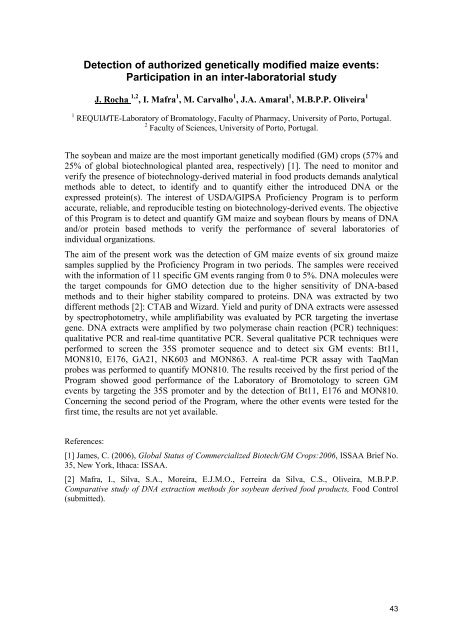IJUP08 - Universidade do Porto
IJUP08 - Universidade do Porto
IJUP08 - Universidade do Porto
- TAGS
- universidade
- porto
- ijup.up.pt
Create successful ePaper yourself
Turn your PDF publications into a flip-book with our unique Google optimized e-Paper software.
Detection of authorized genetically modified maize events:<br />
Participation in an inter-laboratorial study<br />
J. Rocha 1,2 , I. Mafra 1 , M. Carvalho 1 , J.A. Amaral 1 , M.B.P.P. Oliveira 1<br />
1 REQUIMTE-Laboratory of Bromatology, Faculty of Pharmacy, University of <strong>Porto</strong>, Portugal.<br />
2 Faculty of Sciences, University of <strong>Porto</strong>, Portugal.<br />
The soybean and maize are the most important genetically modified (GM) crops (57% and<br />
25% of global biotechnological planted area, respectively) [1]. The need to monitor and<br />
verify the presence of biotechnology-derived material in food products demands analytical<br />
methods able to detect, to identify and to quantify either the introduced DNA or the<br />
expressed protein(s). The interest of USDA/GIPSA Proficiency Program is to perform<br />
accurate, reliable, and reproducible testing on biotechnology-derived events. The objective<br />
of this Program is to detect and quantify GM maize and soybean flours by means of DNA<br />
and/or protein based methods to verify the performance of several laboratories of<br />
individual organizations.<br />
The aim of the present work was the detection of GM maize events of six ground maize<br />
samples supplied by the Proficiency Program in two periods. The samples were received<br />
with the information of 11 specific GM events ranging from 0 to 5%. DNA molecules were<br />
the target compounds for GMO detection due to the higher sensitivity of DNA-based<br />
methods and to their higher stability compared to proteins. DNA was extracted by two<br />
different methods [2]: CTAB and Wizard. Yield and purity of DNA extracts were assessed<br />
by spectrophotometry, while amplifiability was evaluated by PCR targeting the invertase<br />
gene. DNA extracts were amplified by two polymerase chain reaction (PCR) techniques:<br />
qualitative PCR and real-time quantitative PCR. Several qualitative PCR techniques were<br />
performed to screen the 35S promoter sequence and to detect six GM events: Bt11,<br />
MON810, E176, GA21, NK603 and MON863. A real-time PCR assay with TaqMan<br />
probes was performed to quantify MON810. The results received by the first period of the<br />
Program showed good performance of the Laboratory of Bromotology to screen GM<br />
events by targeting the 35S promoter and by the detection of Bt11, E176 and MON810.<br />
Concerning the second period of the Program, where the other events were tested for the<br />
first time, the results are not yet available.<br />
References:<br />
[1] James, C. (2006), Global Status of Commercialized Biotech/GM Crops:2006, ISSAA Brief No.<br />
35, New York, Ithaca: ISSAA.<br />
[2] Mafra, I., Silva, S.A., Moreira, E.J.M.O., Ferreira da Silva, C.S., Oliveira, M.B.P.P.<br />
Comparative study of DNA extraction methods for soybean derived food products, Food Control<br />
(submitted).<br />
43










